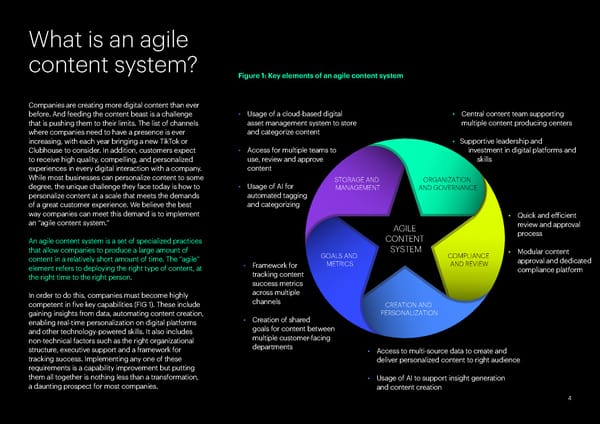What is an agile content system? Figure 1: Key elements of an agile content system Companies are creating more digital content than ever before. And feeding the content beast is a challenge • Usage of a cloud-based digital • Central content team supporting that is pushing them to their limits. The list of channels asset management system to store multiple content producing centers where companies need to have a presence is ever and categorize content increasing, with each year bringing a new TikTok or • Supportive leadership and Clubhouse to consider. In addition, customers expect • Access for multiple teams to investment in digital platforms and to receive high quality, compelling, and personalized use, review and approve skills experiences in every digital interaction with a company. content While most businesses can personalize content to some STORAGE AND ORGANIZATION degree, the unique challenge they face today is how to • Usage of AI for MANAGEMENT AND GOVERNANCE personalize content at a scale that meets the demands automated tagging of a great customer experience. We believe the best and categorizing way companies can meet this demand is to implement • Quick and efficient an “agile content system.” AGILE review and approval CONTENT process An agile content system is a set of specialized practices that allow companies to produce a large amount of GOALS AND SYSTEM COMPLIANCE • Modular content content in a relatively short amount of time. The “agile” • Framework for METRICS AND REVIEW approval and dedicated element refers to deploying the right type of content, at tracking content compliance platform the right time to the right person. success metrics In order to do this, companies must become highly across multiple competent in five key capabilities (FIG 1). These include channels CREATION AND gaining insights from data, automating content creation, • Creation of shared PERSONALIZATION enabling real-time personalization on digital platforms goals for content between and other technology-powered skills. It also includes multiple customer-facing non-technical factors such as the right organizational departments structure, executive support and a framework for • Access to multi-source data to create and tracking success. Implementing any one of these deliver personalized content to right audience requirements is a capability improvement but putting them all together is nothing less than a transformation, • Usage of AI to support insight generation a daunting prospect for most companies. and content creation 4
 State of Digital Content Page 3 Page 5
State of Digital Content Page 3 Page 5